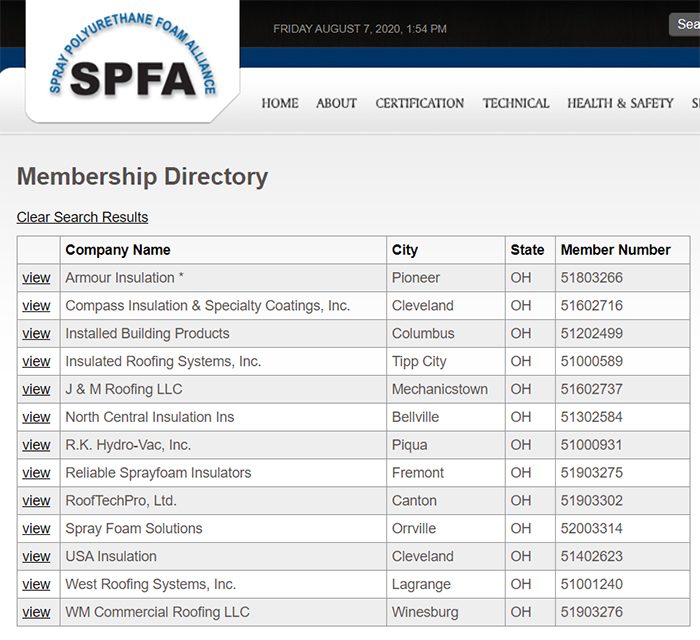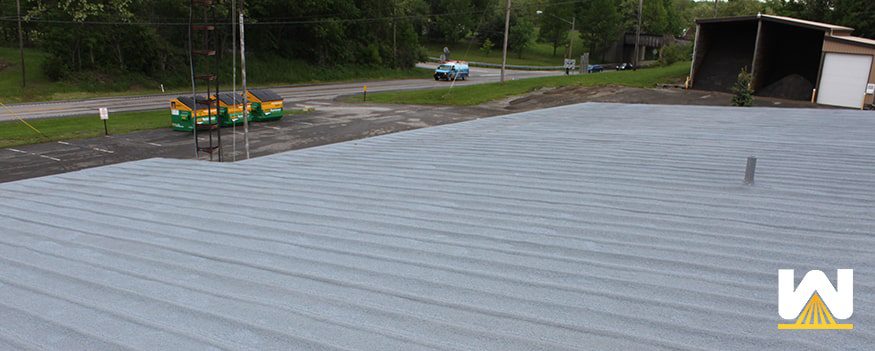Have you ever heard of a spray foam roof?
Based on a LinkedIn poll run by West Roofing Systems, we would say no.
The results?
79% of respondents said they had never heard of a spray foam roof, while 21% said they had.
The results may be misleading, considering that most people who saw the poll know about West Roofing Systems and what we do.
A more accurate measure might be something along the lines of 90% no, 10% yes.
Another fact is that there are tremendous energy-saving statistics that should blow anyone’s mind who’s in the roofing industry.
In the 1980s, Texas A&M University installed spray foam roofs on 27 different buildings. In 4.5 years, they recouped the entire roof installation cost through energy savings!
Here, you can read the 5-page study of spray foam roofs that were installed at Texas A&M University.
So why hasn’t anyone heard of spray foam roofing?
Let’s get started!
Reason #1 – Spray foam roofing gets confused with spray foam insulation
Did you know that spray foam can be used as insulation in a residential home?
I’m sure you probably have.
If you Google almost anything with the term “spray foam” in it, the results will show plenty of information about spray foam insulation.
Also, the Google results are filled with big company names such as Amazon, Home Depot, and Lowe’s who all sell spray foam insulation kits for at-home use.
So, unless you add in “roofing” to your “spray foam” search, you’ll only find information about spray foam installation.
NOTE: A common question is, “Is the spray foam used for residential insulation the same stuff that goes on a commercial roof?”. The answer is no. Most of the time, spray foam for insulation is open-cell, whereas the foam for roofing is closed-cell. There are four main differences between the two spray foams.
Reason #2 – There are many misconceptions about spray foam roofing
When there’s an automatic negative perception of something, it gets tossed away as something you wouldn’t be interested in learning more about.
What are those misconceptions?
There’s a misconception that spray foam is weak.
Closed-cell spray foam is not weak. It can withstand approximately 50-60 PSI of pressure, which is similar to the strength of the pegs that hold your refrigerator up.
There’s a misconception that spray foam is a temporary roofing system.
This couldn’t be further from the truth.
Spray foam is a renewable roofing system, which can be renewed over and over again. West Roofing Systems has several commercial roofs we’ve installed with spray foam in the 1980s which are still going strong today.
After 10-20 years, some of the coating that’s on top of a spray foam roof wears away. On average, this can be from 25 mils of coating on the initial installation, down to 7-10 mils after 15 years.
The amount of coating that wears away depends on the amount of foot traffic, severity of the weather, etc. In most cases, the amount of coating that naturally wears away is a very, very tiny margin.
To renew the roof back to 100%, a recoat takes place.
To recoat the roof, the roof gets cleaned and then the coating is installed back to the original millage.
In the example above, a recoat would bring the 7-10 mils of coating back to 25 mils.
If the roof is properly maintained over its lifetime, none of the existing roof will be removed.
On a traditional roofing system, when the initial warranty is expired, the existing roof is usually completely removed and replaced.
Reason #3 – Building owners are not educated in spray foam roofing
Most building owners are aware of the roofing systems that were popular many decades ago, such as:
Spray foam has been around since the 1960s, but there hasn’t been much written online about it.
There’s the Spray Polyurethane Foam Alliance, but other than that, it’s hard to locate spray foam news without knowing where to go first.
Another reason it’s not “out there” is that there aren’t many spray foam roofing contractors out there doing the actual work.
Upon a quick search online, there are 13 commercial roofing companies right around downtown Cleveland, OH.
For comparison, there are only 13 spray foam roofing contractors in the entire state of Ohio that are registered with the SPFA.

Why are there so few spray foam roofing contractors?
There are two reasons why:
- The equipment used to install spray foam is expensive. A spray foam rig includes air compressors, heated hoses, mixing guns, etc. These are many times more expensive than what a single-ply roofing contractor needs to do their work.
- The learning curve to spray on-ratio foam is steep. To spray on-ratio foam consistently, a contractor needs to be an expert in the chemistry of spray foam. There are three energies of spray foam that need constant attention when installing.
Spray foam roofing is moving forward
There are many advancements in spray foam roofing that indicates the industry is moving forward. One advancement is the formulation of the A and B sides that produce spray foam.
The manufacturers are constantly making changes to adapt to new Montreal Protocol regulations.
Examples of materials that have been phased out include:
- CFC (chlorofluorocarbons) – phasing out CFCs led to HCFCs.
- HCFC (hydro-chlorofluorocarbons) – phasing out HCFCs led to HFCs.
- HFC (hydrofluorocarbons) – phasing out HFCs led to HFOs (hydrofluoro-olefins).
Another advancement is the higher energy efficiency requirements per building codes.
Currently in Ohio, a new roof must have a minimum R-value of 25. If you choose to remove your previous roofing system down to the deck and install a new system, your new roofing system will have to have a minimum R-value of 25.
While the term “spray foam roofing” is taking its time into the general population, as energy efficiency requirements increase and the cost of removing a commercial roof increases, building owners will begin to research more cost-effective solutions.
Ok, what’s next?
Now that you know a little about spray foam roofing, why not learn even more?
West Roofing Systems has been a spray foam roofing contractor since 1979, winning 25+ awards granted by the Spray Polyurethane Foam Association.
Here are popular resources other building owners are interested in:


